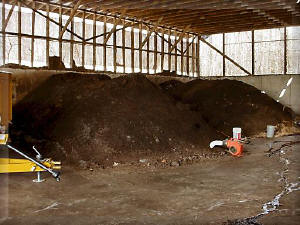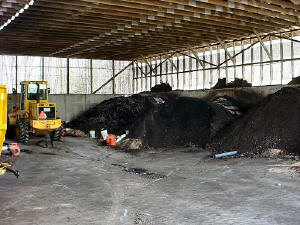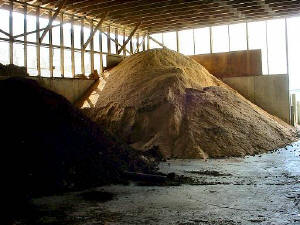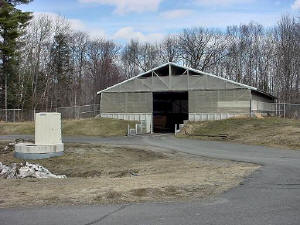![]()
Lincoln, Maine
![]()
| Operations |
| Biosolids Utilization |
| Facility Plan |
| EPA CSO Award |
| Facility Staff |
| Links |
Biosolids
Utilization - Lincoln Sanitary District
All biosolids composted at the facility come from the Lincoln Sanitary District's wastewater treatment plant. The District initially started with the windrow composting method and sometimes used the aerated static pile method. The windrow composting method utilized by the District relies on mechanical turning and natural draft thru the pile to aerate the compost. The aerated static pile composting method utilizes blowers to aerate the compost. The District now uses a modified windrow method that incorporates small blowers pumping air through a piece of pvc pipe located underneath the bottom of each pile. All of the composting is conducted on the plant site in an open-air building to protect the compost from precipitation.
Process Description

Secondary biosolids are co-thickened in the primary clarifiers then pumped to gravity thickeners. Solids are dewatered on 2 one-meter belt presses to a solids content of between 17 and 24 percent with an average concentration of 21%. A cationic polymer is used as a dewatering aid and a solution of Potassium Permanganate is added prior to dewatering for odor control.
The dewatered solids are transported to the compost building via
a 7-yard dump truck. The wastewater treatment solids, green
hardwood sawdust, and recycled compost are mixed in a trailer
mounted PTO driven batch mixer at a 2.5 to 1 or a 3 to 1 ratio
by volume of bulking agents to biosolids. The goal is to achieve
an initial mix of 40% solids for adequate porosity and initial
aeration. The compost mix ratio is adjusted seasonally as needed
to maintain an initial mix of 40% solids.
One compost pile represents one week’s biosolids production at
the District. After the biosolids, sawdust and recycled compost
have been thoroughly mixed; the contents of the mixer are
discharged onto the floor of the compost building. The
articulating loader then piles the mixture against the wall to a
height of six feet by fifteen feet wide by twenty feet long
centered over a piece of 6-inch diameter schedule 80 pvc pipe
that has aeration holes drilled into it. The pipe improves
aeration of the center of the pile through natural draft created
by the warming compost.
The compost piles are arranged in the building so that the
newest pile is placed on the left side of the building entrance
and progressively older piles are arranged in a clockwise
fashion around the perimeter inside the building. The piles are
usually turned 3 days a week. The aeration pipe is pulled out
before the pile is turned. The piles are turned by breaking down
the piles with the loader and reforming the pile to the right.
The next time the piles are turned all rotate back to the left
and so on, back and forth.
When using the static pile method, each new pile is covered with
one foot of finished compost for insulation and to keep odors
down. Air is blown into the pile by attaching a blower to the
pvc pipe underneath the pile. The pile is not moved during this
process.
Pile residence time in the compost building for both methods is
between 30 and 35 days. The compost is then recycled as a
bulking agent or sent to an outside curing and storage area.
After composting, the pile is either recycled as a bulking
agent, or cover, or sent to storage to cure for 90 to 180 days
before distribution.

Salmonella sp. Analysis is conducted once each month and again
on a composite of the stored pile before distribution. Heavy
metals As, Cd, Cr, Cu, Pb, Hg, Ni, Zn, Se, Mo and macro
nutrients as well as compost maturity analysis are sampled and
analyzed twice a year.
The District’s compost meets the exceptional quality criteria
set forth in EPA’s 503 regulations. The compost is distributed
to loam dealers, landscapers, greenhouses and the general public
for use in landscaping, lawn establishment, flowers beds and
gardens, as a mulch, and as an ingredient in potting soil. The
compost program and the marketing plan were developed in house.

Hardwood Sawdust Pile in the
Compost Building
